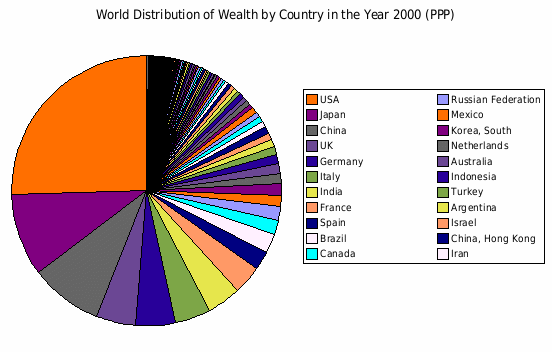The distribution of wealth is a comparison of the wealth of various members or groups in a society. It differs from the income distribution in that it looks at the distribution of asset ownership in a society, rather than the current income of members of that society. There are many ways in which the distribution of wealth can be analyzed. One commonly used method is to compare the wealth of the richest ten percent with the wealth of the poorest ten percent. In many societies, the richest ten percent control more than half of the total wealth. A Pareto distribution is a statistical measure that is often used to model the distribution of wealth, though other mathematical models are also used. The Gini coefficient measures the amount of wealth or income inequality in a society by plotting the proportion of total income (or wealth) earned by the bottom x percent of the population.
Recent Measures of Distribution
At the end of the 20th century, wealth was concentrated among the G8 nations (France, Italy, Germany, Japan, the United Kingdom, the United States, Canada, and Russia) and Western industrialized nations, along with several Asian and OPEC (Organization of Petroleum Exporting Countries) nations. A study by the World Institute for Development Economics Research at the United Nations reports that the richest 1 percent of adults owned 40 percent of global assets in the year 2000, and that the richest 10 percent of adults accounted for 85 percent of the world total. The bottom half of the world adult population owned 1 percent of global wealth. Moreover, another study found that the richest 2 percent of the population owned more than half of global assets as of the year 2000. In terms of distribution of income, a May 2011 report by the Organization for Economic Cooperation and Development (OECD) stated that the gap between rich and poor in OECD countries (most of which are "high income" economies) was at its highest level since the 1970s.
Real Estate
One form of wealth is land or real estate. As with general wealth distribution, land is also distributed unequally. Sizable numbers of households own no land, while a small percentage of people at the top of the economic hierarchy own most of the world's privately held land. For example, 10 percent of land owners in Baltimore, Maryland own 58 percent of the taxable land value. The bottom 10 percent of those who own any land own less than 1 percent of the total land value.
World Distribution of Financial Wealth
In 2007, 147 companies controlled nearly 40 percent of the monetary value of all transnational corporations. On an international level, wealth is distributed unequally between nations, which are stratified in a world economic order.
Redistribution of Wealth and Public Policy
In many societies, attempts have been made to redistribute wealth through property redistribution, taxation, or regulation. Sometimes these policies are engineered to favor the upper class, while in other cases they are intended to diminish inequality between the upper and lower classes. Examples of this practice go back at least to the Roman republic in the third century B.C., when laws were passed limiting the amount of wealth or land that could be owned by any one family. Motivations for such limitations on wealth include the desire for equality of opportunity, a fear that great wealth leads to political corruption, the belief that limiting wealth will gain the political favor of a voting bloc, or fear that extreme concentration of wealth results in rebellion.
Various forms of socialism, an economic system in which the state exerts significant control over wealth distribution, attempt to diminish the unequal distribution of wealth and the conflicts that arise from it. Communism, an economic system that (in its ideal form) consists of state ownership of assets and industry and the equal distribution of resources among the population, can be seen as an attempt to eradicate wealth inequality through government policy. An idea taken from Karl Marx's Communist Manifesto is that wealth should be distributed as according to the precepts of, "From each according to his ability, to each according to his need. " While states such as the Soviet Union and China have implemented communist systems to varying degrees, Marxism has never been realized in its ideal form, and no country has had a totally equal distribution of wealth.
In addition to government efforts to redistribute wealth, the tradition of individual and organizational charity is a voluntary means of wealth transference. Many voluntary charitable organizations make concerted efforts to aid those in need by redistributing wealth and material resources.

Global Distribution of Wealth by Country (2000)
This pie chart shows the global distribution of wealth among countries, illustrating the point that a small number of countries hold the majority of global assets.